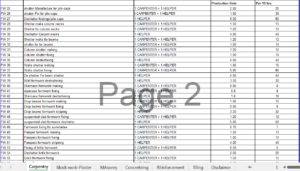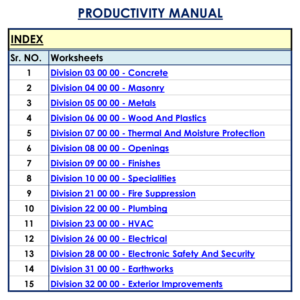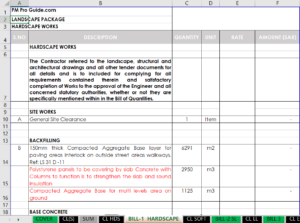What Are Standard Labor Productivity Rates in Construction PDFs?
Standard labor productivity rates in construction pdf provide a standardized reference for tracking and assessing the efficiency of labor in construction projects. These rates serve as a benchmark, enabling construction professionals to evaluate their projects and make data-driven decisions.
Download Standard Labor Productivity Rates in construction pdf for free
PM Pro Guide offers a free PDF guide for all productivity rates in construction, divided by divisions of work.
Division 03 00 00 – Concrete Standard Productivity Rates
Division 04 00 00 – Masonry Standard Productivity Rates
Division 05 00 00 – Metals Standard Productivity Rates
Division 06 00 00 – Wood And Plastics Standard Productivity Rates
Division 07 00 00 – Thermal And Moisture Protection Standard Productivity Rates
Division 08 00 00 – Openings Standard Productivity Rates
Division 09 00 00 – Finishes Standard Productivity Rates
Division 10 00 00 – Specialities Standard Productivity Rates
Division 21 00 00 – Fire Suppression Standard Productivity Rates
Division 22 00 00 – Plumbing Standard Productivity Rates
Division 23 00 00 – HVAC Standard Productivity Rates
Division 26 00 00 – Electrical Standard Productivity Rates
Division 28 00 00 – Electronic Safety And Security Standard Productivity Rates
Division 31 00 00 – Earthworks Standard Productivity Rates
Division 32 00 00 – Exterior Improvements Standard Productivity Rates


Download the Standard labor productivity rates in construction pdf
Why do we need Standard Labor Productivity Rates?
Efficient labor utilization is the backbone of any construction project. Here’s why standard labor productivity rates are of utmost importance:
Enhancing Project Planning
Standard rates allow project managers to plan labor requirements accurately. This minimizes delays, reduces costs, and ensures smooth project execution.
Evaluating Performance
Comparing actual productivity against standard rates helps identify areas where improvements are needed. This data-driven approach fosters accountability and continuous improvement.
Cost Control
Efficient labor management leads to cost control. By adhering to standard rates, projects can avoid overstaffing and related expenses.
Calculating Standard Labor Productivity Rates
Calculating standard labor productivity rates involves several steps:
- Define the Scope: Clearly define the scope of work and the specific tasks involved in the project.
- Measure Work Output: Measure the amount of work completed in a specified time frame.
- Determine Labor Hours: Calculate the number of labor hours required to complete the work.
- Calculate Rate: Divide the work output by the labor hours to determine the productivity rate.
Factors Affecting Labor Productivity
Several factors can impact labor productivity in construction:
Skill and Experience
Highly skilled and experienced workers tend to be more productive than those with less experience.
Work Conditions
Adverse weather, safety protocols, and site conditions can either hinder or enhance productivity.
Equipment
The availability and functionality of construction equipment can significantly affect productivity.
Management and Supervision
Effective management and supervision ensure that workers stay on task and adhere to schedules.
Improving Labor Productivity
Enhancing labor productivity requires a multi-faceted approach:
Training and Skill Development
Investing in training and skill development programs for workers can boost their efficiency.
Technology Adoption
Embracing technology, such as construction management software, can streamline processes and improve productivity.
Clear Communication
Effective communication between team members and management is essential for productivity.
Incentives
Implementing incentive programs can motivate workers to perform at their best.
FAQs
Q: What is the ideal labor productivity rate for construction projects? A: There is no one-size-fits-all answer to this question as rates vary depending on project complexity. It’s best to consult industry standards and benchmarks for guidance.
Q: How often should labor productivity rates be updated? A: Labor productivity rates should be reviewed regularly, ideally after the completion of each project. This allows for adjustments based on real-world data.
Q: Can labor productivity rates vary by region? A: Yes, labor productivity rates can vary based on geographic location, labor market conditions, and local regulations.
Q: Are there industry-specific standards for labor productivity? A: Yes, various construction sectors may have their own specific labor productivity standards and benchmarks.
Q: How can I track and measure labor productivity effectively? A: Utilize software and tools designed for construction project management to track labor hours, work output, and productivity rates.
Q: What is the role of project managers in optimizing labor productivity? A: Project managers play a crucial role in planning, coordinating, and optimizing labor resources to ensure productivity goals are met.
Conclusion
Standard labor productivity rates in construction PDFs are invaluable tools for construction professionals. They provide a foundation for efficient project planning, performance evaluation, and cost control. By understanding the significance of these rates and implementing strategies for improvement, construction projects can run more smoothly and cost-effectively.



























